
LOGARTA
Many reasons encourage us to integrate gender within the curriculum. As I have previously mentioned, it would help us understand certain social issues like violence against women. If we trap people in their gender roles, we would be perpetuating inequality. This inequality gives rise to violence; for it is when males view females as objects, or weaker creatures, or persons to be controlled that males tend towards violence.
If we clarify gender as emerging from our culture and that therefore is not natural but socially shaped, we realize how events and social realities shape the expectations related to gender roles. Then we realize that these can be changed. We, therefore, understand that we need to reflect on their validity as a practical instruments in our lives.
In some places, gender roles have limited the options for females. In several places in Asia and Africa, entering school is not open to women with the belief that they are meant to bear children and raise them so there is no need for formal education. Many like the heroic Malala have fought this kind of narrowness and suffered being shot for such an idea. We have to open minds and doors for female children. If we free girls from such cultural limitations, we are not only liberating her but also her family and her community. Much has been said about the change generated when females are educated. Their children will have more chances to be educated. These children will be healthier and they will be fewer. It would actually result in savings for the government.
Released from the constraints of gender roles, women will be a great resource for our society. But liberating women will also free men. As this poem says: “For every woman/ Who is denied meaningful employment and equal pay/There is a man/Who must take responsibility for another human being//For every woman who was not taught the intricacies/ of an automobile/ There is a man/ who was not taught the satisfaction of cooking.// For every woman/ Who takes a step toward/ her own liberation/ There is a man/ Who finds that the way/ To Freedom has been made a/ little easier.
How do we liberate our students from their gender roles in school? It has been done by changing Practical Arts and Home Economics with Technology and Livelihood Education. In this subject both males and females learn the same skills. This results in the independence of both. Both can learn carpentry and sewing. At the same time we adapt to recent technological changes, providing both with the same skills. In assigning tasks we should also be gender fair — not always letting girls be the receptionists or the secretaries. In the case of teachers who are role models in school, administrators are encouraged to hire male teachers for communication subjects, especially reading for the pupils in early childhood education. We need to make little boys feel that books and reading are not only for females.
The Magna Philippine Carta of Women itself encourages gender fairness in school. It encourages schools to make sure that there is fairness in granting scholarships. It invites them to create enthusiasm for sports among females, since more sports activities seem to be available for males. The law would not want to deprive females of such health-promoting activities.
Communication educators must be on the alert regarding gender-biased language and present the alternative of more gender-fair words. For the limitations of learning materials, educators must be ready to make the corrections. For the absence of women in history or on the write-up of scientists, educators can assign research projects that will make the students more informed about the actual contributions of women in shaping our past. In reading about current events they need to learn how females affected by conflicts and disasters. But they also need to know how women are taking part in the building of resilient and peaceful communities. Do they know what Irene Santiago is doing regarding the Marawi crisis? Have we prepared to discuss with our students the activities of the women in the revolution which led to the Declaration of Independence?
In relation to the declaration of our independence done by Emilio Aguinaldo, we need to remember that it was done to invite more participants in the national struggle for freedom and nationhood. So I hope that the manner of celebration will be in this spirit of awakening all to our ongoing effort to realizing the nation of our aspirations, so I ask the students to march and sing:
A gubat ni Leon Kilat taas ng pakigbisong
Dugay kining matapos
Kita ang motiwas !
Disclaimer: The comments uploaded on this site do not necessarily represent or reflect the views of management and owner of Cebudailynews. We reserve the right to exclude comments that we deem to be inconsistent with our editorial standards.
